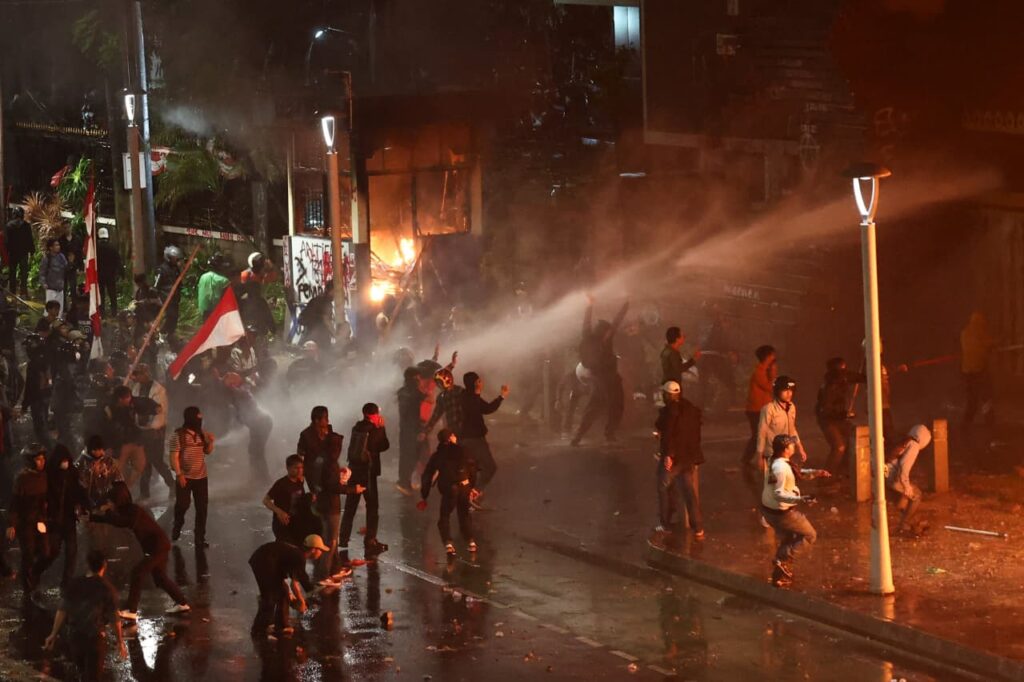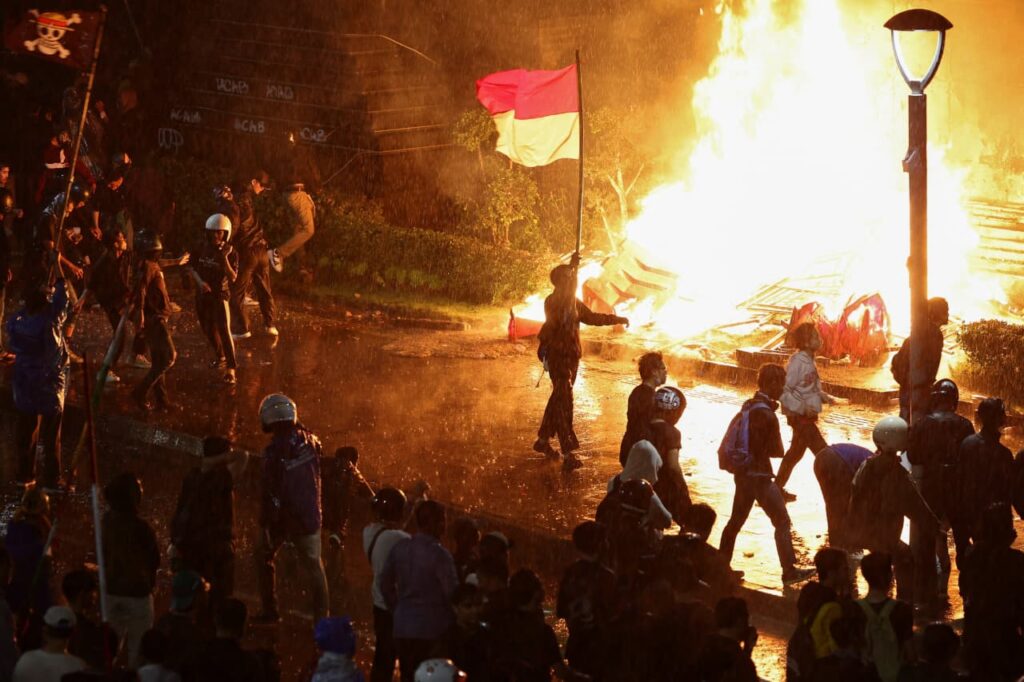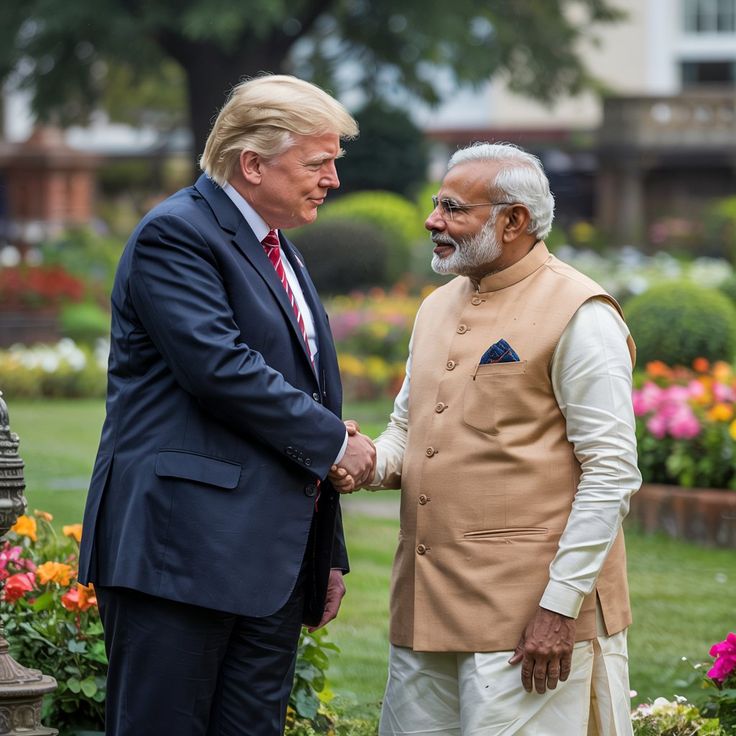A Nation in Turmoil
Indonesia, the world’s third-largest democracy, is witnessing a wave of protests that have quickly escalated into deadly confrontations. When demonstrators set fire to a provincial parliament building in Makassar, the capital of South Sulawesi, on Friday night, the protests went out of hand. According to local authorities and disaster management officials, at least a dozen people lost their lives and many others were injured, making this one of the most violent political flashpoints in recent years.
The unrest poses the first significant test for President Prabowo Subianto’s government, which came to power less than a year ago. Concerns about security, public trust, and governance are taking center stage in national discussions as tensions extend beyond Jakarta to other significant Indonesian cities.
The Tragedy in Makassar: How the Fire Turned Deadly
Eyewitnesses and local media reports describe a harrowing scene in Makassar on Friday evening. The parliament building, a key symbol of regional governance, was engulfed in flames after protesters set it ablaze.
Victims Trapped Inside
According to Antara News Agency, several victims were trapped inside the burning building. Some were unable to escape, while others sustained injuries by jumping from windows in a desperate bid to survive. The country’s disaster management agency confirmed that at least two injuries came from such falls, underscoring the chaos and fear that gripped the site.
Unanswered Questions
Authorities have not yet confirmed the exact causes of death, but the scale of the tragedy has sent shockwaves across the nation. For many Indonesians, the incident is not just about property destruction—it symbolizes deep-seated frustration and the risks of escalating protests.
Why Indonesians Are Protesting: The Pay Controversy and More
At the heart of the unrest lies public anger over lawmakers’ pay. Earlier this week, protests started in Jakarta, where participants expressed their disapproval of what they saw as the disproportionate wages and privileges received by members of parliament.
The Trigger: A Deadly Incident in Jakarta
After a police armored vehicle murdered a motorbike driver employed for a ride-hailing business, the protests became much more intense. The accident, seen by many as a symbol of state insensitivity, ignited outrage. Demonstrators argue that the government is failing to protect ordinary citizens while politicians continue to enjoy privileges.
Broader Discontent
While pay raises for lawmakers acted as a spark, analysts suggest that the protests reflect broader dissatisfaction with economic inequality, governance issues, and rising living costs. For Indonesia’s youth and working-class citizens, the demonstrations have become an outlet for long-standing frustrations.
President Prabowo Subianto’s Response: Sympathy and Responsibility
President Prabowo Subianto, who assumed office in October last year, has found himself in the eye of the storm. On Friday night, he visited the home of the deceased motorbike driver in Jakarta, offering condolences to grieving parents.
Promises of Accountability
Prabowo publicly vowed to oversee a full investigation into the young man’s death, promising transparency and justice. However, many protestors remain skeptical, viewing his words as insufficient against the backdrop of continuing violence and unrest.
A First Test of Leadership
This crisis is widely considered the first major test of Prabowo’s presidency. Known for his military background and nationalist rhetoric, he must now balance firmness with compassion—reassuring the public while preventing further violence.
Escalation Across Cities: From Jakarta to Yogyakarta
The unrest is not limited to Makassar. Demonstrations have spread like wildfire across Indonesia’s largest cities, from the bustling capital of Jakarta to the cultural hubs of Bandung and Yogyakarta.
Looting and Property Damage
Local media outlets in Jakarta have occasionally reported on looting and damage to the city’s transit system. Protesters clashed with police, and security forces responded with water cannons and tear gas in certain districts.
Public Transport Disruptions
Jakarta’s mass rapid transit railway announced that trains would skip one of their busiest stations due to safety concerns near Friday’s protest site. Similarly, TransJakarta bus services reported disruptions as authorities tried to prevent mobs from hijacking public facilities.
These disruptions highlight the broader social and economic costs of the protests, which affect not just politics but also daily life for millions of Indonesians.
International Attention and Regional Concerns
International attention has been drawn to the protests because of their size and violence. Neighboring Southeast Asian countries are monitoring the situation closely, given Indonesia’s role as the region’s largest economy and a key member of ASEAN.
Global Investors on Edge
With Indonesia being an emerging market hub for trade, tourism, and investment, global investors are concerned about the potential economic fallout. Prolonged unrest could shake investor confidence and disrupt supply chains in the region.
Human Rights Concerns
International human rights organizations have also expressed concern about the state’s handling of protests. While acknowledging the regrettable casualties, activists are calling on Indonesian authorities to respect protestors’ rights and maintain balanced policing.
Human Stories Amid the Chaos
Behind every statistic lies a human story. The 12 lives lost in Makassar represent families devastated, communities shaken, and futures cut short.
The Ride-Hailing Driver: A Symbol of Protest
The death of the motorbike driver in Jakarta has become a rallying cry for many Indonesians. For the working-class population, his story resonates deeply—a young man working hard to support his family, only to lose his life in an accident involving a state vehicle.
Protesters’ Voices
On the streets of Jakarta, protesters carried banners reading “Justice for the People” and “Stop Lawmakers’ Greed.” For them, the fight is not just about pay raises but about accountability, fairness, and dignity in a country where wealth gaps remain stark.
What This Means for Indonesia
The coming weeks will be crucial for Indonesia’s political stability. Several questions loom large:
1. Will Prabowo Subianto’s government manage to calm tensions without resorting to excessive force?
2. Can the administration address the root causes of discontent, including inequality and political mistrust?
3. How will these protests affect Indonesia’s economy, especially tourism and investment confidence?
Possible Scenarios
De-escalation through dialogue: If the government initiates meaningful discussions with protest leaders, there may be a chance to restore calm.
Escalation and crackdown: If protests intensify and security forces respond with force, Indonesia could face a deeper political crisis.
Long-term changes: In order to rebuild public confidence, politicians may be compelled by the occurrence to reevaluate contentious compensation practices and enact changes.
A Nation at a Crossroads
Indonesia stands at a critical crossroads. The deadly protests in Makassar and Jakarta are not isolated incidents but part of a larger narrative of public dissatisfaction, political accountability, and social inequality. The situation is both a challenge and an opportunity for President Prabowo Subianto, who must decide whether to risk more instability or restore trust through significant reforms.
As families mourn, businesses brace for uncertainty, and international observers keep a close eye, the world is reminded that the health of a democracy is tested not only in elections but also in how leaders respond to the voices of their people during times of crisis.
Related News: Read More




